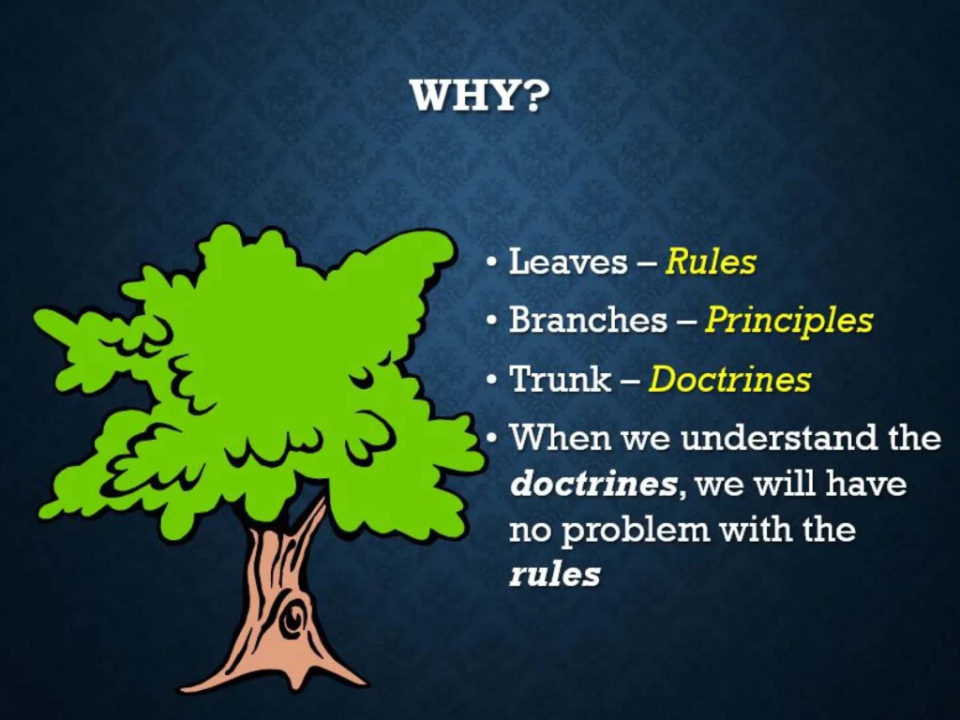
Young-Women-Australia
Young women in Australia participate in an outdoor activity. Brother John G. Bytheway compares rules, principles and doctrines to the leaves, branches and trunk of a tree.2022 by Intellectual Reserve, Inc. All rights reserved.
This story appears here courtesy of TheChurchNews.com. It is not for use by other media.
By Brother John G. Bytheway of the Young Men General Advisory Council
Suppose you worked for a landscaping company and you had an assignment to cut down a tree. And suppose after a few hours, all you did was bring your supervisor a bag full of leaves. Your supervisor might say you missed the point. Most of the tree is still there. There’s a lot more to trees than just the leaves.
Further, let’s say you were trying to describe a tree to someone who had never seen one before. If all you did was tell them about leaves, you’d be leaving out most of the tree, wood you not? (Ha, ha.)
Rules are like leaves. They don’t just float in midair. They are supported by branches, which are supported by a strong trunk and sturdy roots.

John-Bytheway-Principles-1
Rules are like leaves, branches are like principles, and the trunk and roots are like doctrines. Graphic courtesy of John G. Bytheway, courtesy of Church News.All rights reserved.
For example, Elder Jeffrey R. Holland of the Quorum of the Twelve Apostles once suggested that, wherever possible, the young men of the Aaronic Priesthood should try to wear a white shirt while preparing and passing the sacrament. Is there a principle and doctrine behind that simple suggestion? Yes. Elder Holland went on to explain that one of the principles supporting the suggestion about wearing white is reverence. We honor the Lord when we show reverence for sacred things, like the sacrament. We wear white when we’re baptized and when we go through the temple. Since white is a symbol of purity, we show reverence for the sacrament when we wear white, and our reverence in the way we dress may help remind others of their baptism and temple covenants as well (see “This Do in Remembrance of Me,” October 1995 general conference).
The doctrine behind the sacrament might be like the trunk and roots that support the rule. The sacrament reminds us of the sacrifice Jesus made for each of us and gives us a chance to renew our covenants, which fills us with reverence. If every young man in the Aaronic Priesthood focused on the doctrine of the Atonement of Jesus Christ and the principle of reverence for sacred things, he would have absolutely no problem with the rule.
The teachings of Jesus Christ are so much more than a long list of do’s and don’ts, just as a tree is more than a bag of leaves. The closer we look and the more we ponder, the more we’ll begin to recognize the plan of a loving Heavenly Father behind all the rules. He loves us so much that sometimes he says “no.” Other times, he says “not yet.” Why? To limit our freedom? No. To make us miserable? No. To protect us from consequences — to help us become holy like He is and to lead us to maximum happiness.
Asking ‘Why?’ Can Lead Us to Principles
Many of the rules we talk about concern modern media and technology. We live in an incredible age, where many of us carry in our pockets a mobile phone — which is a still camera, a movie camera, a cellphone, a communications device, a computer and a portal to the world’s database of information. Because our screens or devices are such powerful tools, they can also be used as weapons against us, which is why we need rules and boundaries.
The Rule: “Don’t participate in anything that dulls your judgment or sensitivity to the Spirit, such as violence, alcohol and harmful drugs. Have the courage to turn off a video or game, walk out of a movie or a dance, change your music, or turn away from anything that is not consistent with the Spirit” (“For the Strength of Youth,” “Walk in God’s light,” 18).
So here’s the question — why shouldn’t I watch movies or videos that are not uplifting? It’s OK to ask “Why?” We could probably come up with lots of answers: Because it’s bad. Because by watching, we’re participating in bad behavior. Because we’ve been asked not to. Because we’re supporting those that make bad stuff.
All of those responses are correct, but more important than what happens out there is what happens in our hearts.
Let’s look for the principle, or the branch that supports the leaf, in “For the Strength of Youth”:
The Principle: “Seek that which uplifts, inspires and invites the Spirit. As you make choices about what to watch, read, listen to or participate in, think about how it makes you feel. Does it invite good thoughts?” (“For the Strength of Youth,” “Walk in God’s light,” 18).
Now we’re getting somewhere. Everything you do has a consequence. Everything you watch has an effect on you. Now, let’s keep reading and we’ll discover the doctrine.
The Doctrine: “The Lord blesses you with the opportunity to have the Holy Spirit as your constant companion. It is one of His greatest gifts to you” (“For the Strength of Youth,” ”Walk in God’s light,” 17).
There’s the doctrine. Good entertainment allows you to keep the Holy Ghost. Each week at the sacrament table, we make a covenant that we will keep the commandments God has given us, so that we may always have His Spirit with us.
Someone Wants You to ‘Surrender Your Sword’
The closer we read “For the Strength of Youth,” the more you’ll recognize not just the leaves and branches, not just the rules and principles, but we will also see the roots — the doctrines beneath every rule. The doctrine you’ll notice throughout the guide has to do with a gift many of us received around our eighth birthday. This invisible gift is so powerful, and so valuable, that the Lord once called it the “unspeakable gift of the Holy Ghost” (Doctrine and Covenants 121:26). The Holy Ghost is a guide and a protection. In fact, it’s even a weapon to help you in this test of survival we call life.

Bytheway-John-G-819x1024.jpg
Brother John G. Bytheway, Young Men general advisory council member.2022 by Intellectual Reserve, Inc. All rights reserved.What? The Holy Ghost is a weapon? Yes. You remember the Apostle Paul’s description of the armor of God — the shield of faith, the breastplate of righteousness, the helmet of salvation, loins girt about with truth, and feet shod with the gospel of peace (Ephesians 6, Doctrine and Covenants 27).
Now, if you’ll picture the warrior described above, you’ll notice that something was left out of Paul’s description. What’s missing? The warrior has only defensive armor. But with a sword, with a weapon, that warrior can go into the world and defend himself, and even fight back. Where will the warrior get a sword? God wouldn’t send us into the world unarmed, would he? No. He gave us a gift. He gave us a weapon. He gave us the “sword of the Spirit” (Ephesians 6:17). Yes, the Holy Ghost is a sword, a powerful weapon to help you fight back when the temptations and false ideas of the world surround you.
Elder Holland explained: “Are we to be only on the defensive? Are we to simply ward off blows and see it through and never be able, spiritually speaking, to strike a blow? No. We are supposed to advance in this and win a battle that started in heaven long ago. ... The weapon that is mentioned, the thing that allows us to actually do battle with the ‘darkness of the world,’ to use Paul’s phrase, is ‘the sword of the Spirit, which is the word of God.’ (“Therefore, What?” an address given at the 2000 New Testament Conference, Brigham Young University, Aug. 8, 2000, 2).
Our chances for the greatest joy and happiness in life come from enjoyment of the companionship of the Holy Ghost, the doctrine and the goal behind all the rules. Trees do not grow from the leaves down, but from the roots up. In the same way, discussions about the standards of the gospel, the rules the Lord has given for our behavior, should always start from the ground up — from the roots.
Copyright 2022 Deseret News Publishing Company.